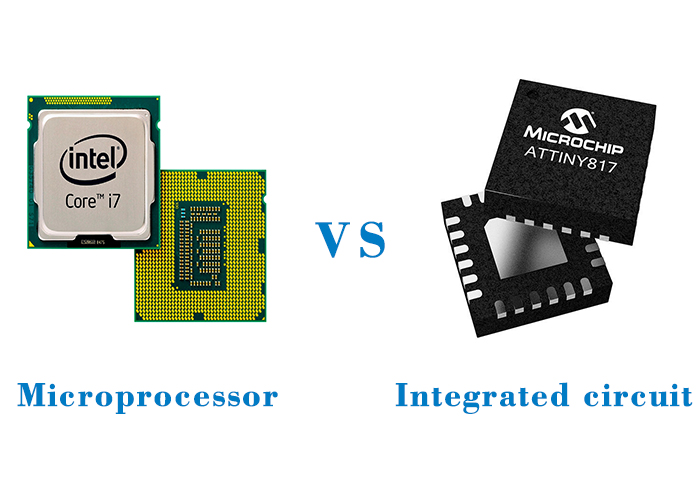Introduction
In the heart of the digital age, two fundamental elements continuously shape our world - microprocessors and integrated circuits. They underpin the operation of numerous devices we interact with daily, from smartphones and computers to automation systems and spacecraft.
The microprocessor and integrated circuit – two formidable forces in the realm of electronics – have unique roles, structures, and functions. Yet, their shared purpose of executing complex tasks quickly and efficiently is what binds them together. This article will explain in detail how a microprocessor differs from an integrated circuit.

What is a Microprocessor?
A microprocessor is a type of integrated circuit that contains the functions of a central processing unit (CPU) of a computer on a single chip. The CPU is essentially the "brain" of a computer system because it controls and performs the execution of instructions.
Microprocessors were developed in the 1970s and are one of the key components that enabled the development of powerful, yet increasingly compact personal computers. As semiconductor technology has advanced, the complexity and capabilities of microprocessors have also increased, with modern chips containing billions of transistors.
Microprocessors can be found in a variety of devices, from computers and servers to consumer electronics like smartphones, tablets, and even home appliances. They perform a range of tasks, from simple control functions to complex mathematical operations.
The architecture of a microprocessor includes components like the arithmetic logic unit (ALU), which performs calculations; control units, which manage the fetching and execution of instructions; and registers, which are small amounts of very fast storage used to hold instructions, data, and intermediate results.
Microprocessors are designed with different instruction set architectures (ISAs), which define the specific details about how instructions are executed, including data types, registers, addressing modes, memory architecture, and more. Some common ISAs include x86, ARM, and MIPS.
Advantages of Microprocessors
Speed: High processing speed for quick data execution.
Size: Compact form factor for space-saving integration in devices.
Versatility: Programmable and adaptable for various applications.
Cost-Effective: Economical production and availability in large quantities.
Energy Efficiency: Low power consumption for improved energy management.
Disadvantages of Microprocessors
Complexity: Requires specialized knowledge for programming and implementation.
Heat Generation: Produces heat that needs to be managed to prevent overheating.
Compatibility Issues: Compatibility challenges with different systems and components.
Vulnerability: Susceptible to external factors such as electrical interference.
Limited Processing Capabilities: May not be suitable for highly specialized or resource-intensive tasks.
What is an Integrated Circuit?
Integrated Circuits (ICs), often referred to as microchips or simply chips, are compact arrangements of semiconductor devices and tiny circuits built on a single piece of a semiconductive material, usually silicon. They are integral components of virtually all electronic equipment in use today and have revolutionized the world of electronics.
The invention of ICs marked a significant turn in the field of electronics, enabling the miniaturization and mass production of complex electronic devices. They have made it possible to condense thousands, millions, or even billions of transistors and other electronic components into a small chip, thereby drastically reducing the size, weight, cost, and power consumption of electronic devices, while also improving their reliability and speed.
ICs come in various types based on their functionality and complexity:
Analog ICs, also known as linear ICs, are used for operations that require variable signal inputs such as radio frequency amplification, audio processing, and temperature control.
Digital ICs operate with digital data and are often based on Boolean algebra. They are used in digital devices such as computers, calculators, and data transmission devices. Digital ICs include microprocessors, memory chips, and logic ICs.
Mixed-signal ICs combine both analog and digital circuits on a single chip. They are typically used in devices such as smartphones and digital audio and video equipment.
The design and manufacture of ICs involve a range of scientific disciplines, including physics, chemistry, and electrical engineering, and require highly sophisticated fabrication techniques. As semiconductor technology continues to evolve, we can expect the capabilities of ICs to grow, enabling new possibilities in the field of electronics.
Advantages of Integrated Circuits
Miniaturization: ICs are small in size, allowing for compact and lightweight electronic devices.
Improved Performance: Integrated circuits provide high-speed operation, increased computational power, and enhanced functionality.
Cost Efficiency: Mass production of ICs lowers manufacturing costs, making them affordable for various applications.
Reliability: ICs have fewer interconnections, reducing the risk of loose connections and improving overall reliability.
Power Efficiency: Integrated circuits consume less power, resulting in longer battery life for portable devices.
Disadvantages of Integrated Circuits
Complexity: Designing and manufacturing ICs require specialized knowledge, advanced equipment, and complex fabrication processes.
Lack of Customization: Once an IC is fabricated, it is challenging to modify or customize its functionality.
Sensitivity to Environmental Factors: Integrated circuits can be sensitive to temperature variations, humidity, and electromagnetic interference.
Testing and Quality Control: Ensuring the functionality and reliability of ICs involves rigorous testing and quality control procedures.
Obsolescence: Rapid technological advancements render older ICs obsolete, necessitating frequent upgrades and replacements.
Microprocessor vs Integrated Circuit
A microprocessor and an integrated circuit (IC) are both critical components of modern electronics. They each have specific functions, characteristics, and applications. The following describes how microprocessors differ from integrated circuits:
Microprocessor vs integrated circuit| Criteria | Microprocessor | Integrated Circuit |
|---|
| Definition | A type of IC that performs computations and executes instructions. | An assembly of electronic components and circuits on a single chip. |
| Functionality | Executes a program stored in memory, performing calculations and making decisions based on the program's instructions. | Varies greatly, can include amplification, oscillation, timing, counting, and microcomputing. |
| Complexity | Highly complex, containing millions or billions of transistors. | Varies from simple (a few transistors) to highly complex (millions or billions of transistors). |
| Types | Primarily digital, used in computing and data processing. | Includes digital (microprocessors, memory chips, logic ICs), analog (amplifiers, oscillators), and mixed-signal ICs. |
| Application Examples | Personal computers, servers, smartphones, embedded systems. | Radios, TVs, mobile phones, computers, audio equipment, industrial control systems. |
| Customizability | Generally not customizable after manufacture. | Can be either fixed in functionality (ASICs) or programmable (FPGAs, CPLDs). |
| Dependence on External Components | Requires memory and other ICs (such as input/output devices) to function. | May work independently or as part of a larger circuit, depending on the complexity and intended use. |
In essence, while all microprocessors are integrated circuits, not all integrated circuits are microprocessors. The microprocessor is a specialized, programmable type of integrated circuit designed to process information and control other devices.
Conclusion
Microprocessors and integrated circuits - have unique characteristics and broad applications. In this article, we microprocessor vs integrated circuit. We understand How is a microprocessor different from an integrated circuit and they apply

Nantian Electronics a professional distributor of electronic components, providing a wide range of electronic products, saving you a lot of time, effort and cost through our meticulous order preparation and fast delivery service.
Share this post



FAQ
1.Is microprocessor an integrated circuit?
Yes, a microprocessor is an integrated circuit (IC) that serves as the CPU of a computer or device, executing instructions and performing calculations. It incorporates millions or billions of components onto a single chip.
2.Is a microprocessor an IC?
Yes, a microprocessor is an integrated circuit (IC). It serves as the central processing unit (CPU) of a computer or device, executing instructions and performing calculations. A microprocessor integrates numerous components, including transistors, logic gates, and memory, onto a single chip, enabling efficient and compact computing capabilities.
3.What is the nickname for integrated circuit?
The nickname for an integrated circuit (IC) is "chip." It is a fundamental component of modern electronics, allowing for the integration of complex circuits onto a single semiconductor material.
4.Why is microprocessor called integrated circuit?
A microprocessor is referred to as an integrated circuit (IC) because it incorporates multiple intricate circuits, including logic gates, arithmetic units, and control units, onto a single semiconductor chip. This integration allows the microprocessor to efficiently carry out calculations and execute instructions within a compact and unified package. By consolidating numerous circuit components onto one chip, the microprocessor achieves enhanced performance, reduced power consumption, and lowered manufacturing expenses compared to discrete circuit designs.
5.What is a microprocessor in simple terms?
In simple terms, a microprocessor is the central component of a computer system, often referred to as the "brain" of the computer. It is an electronic circuit that performs various tasks such as executing instructions, processing data, and managing the overall operation of the system. The microprocessor receives input from different sources, such as keyboards, mice, or memory, and performs calculations and logical operations based on these inputs. It then generates output, which can be in the form of visual display, sound, or data sent to other devices. The microprocessor's speed and efficiency allow computers to perform complex tasks quickly and effectively. It serves as the core processing unit that enables the execution of software programs and the overall functioning of the computer system.
6.What are the two types of microprocessor?
The two primary types of microprocessors are general-purpose and application-specific. General-purpose microprocessors are versatile and commonly used in personal computers, laptops, and servers. On the other hand, application-specific microprocessors are designed and optimized for specific tasks or applications, such as those found in smartphones, cameras, and automotive systems.
7.What makes a microprocessor?
A microprocessor is comprised of essential components such as the Control Unit (CU), Arithmetic Logic Unit (ALU), Registers, Clock, Cache Memory, Bus System, Instruction Set, and Input/Output Interfaces. These components collaborate to execute instructions, carry out calculations, store data, and interface with external devices, serving as the core of computing systems.